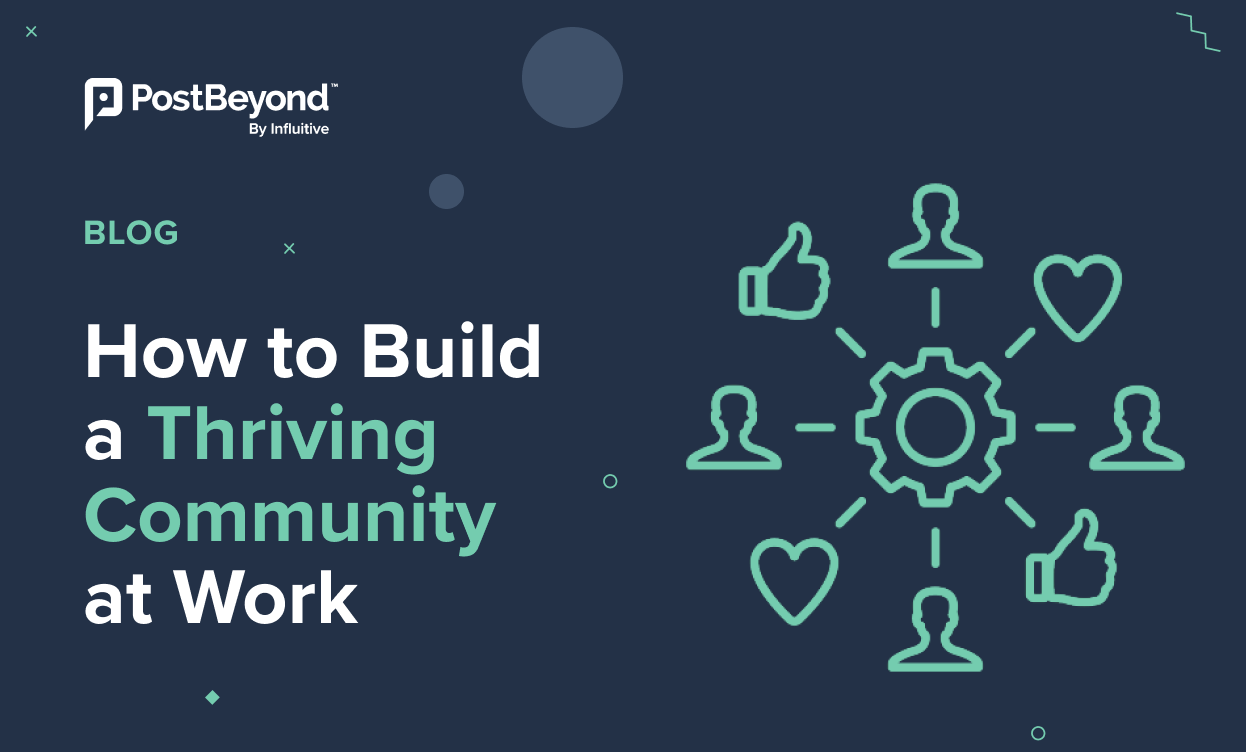A recent study found that happy workers are 12% more productive than the average worker. Further, research from the World Health Organization argues that unhappy workers suffering from depression and anxiety could cost the global economy $1 trillion every year.
But with paid work ranking at the bottom of activities that make people happy, the question becomes ‘how on earth do you lighten the mood’?
For starters, it’s not that happier workers work longer hours. So for those of you reaching for your employee timesheets, you can leave them be. It’s that workers are more productive when they’re working.
So, as value-based leaders, how do we reconcile the gap between work and happiness?

Start with community
Over the years, developers have built a dizzying amount of business continuity software, human resources software and fulfillment planning to track the well-being of workplace communities. That fact alone emphasizes their importance.
Admittedly, to the casual observer, this mountain of software can make the subject of community a complex topic to handle. But what remains clear to everyone involved is the relationship between community and happiness.
Which is why, in this blog, we’ll walk you through the three top tips you can use to foster the community your employees deserve (and the productivity your business needs).
Let’s get started.
Tip 1: Start with “why”
Best-selling author, motivational speaker, and modern-day workplace expert Simon Sinek started with “why”. And look where that got him.
In his famous book Start with Why, Sinek emphasizes the importance of first identifying the key motivators behind any pursuit. It is this approach that was vital to both his own success and that of many other organizations. Today, we’re taking a page from his book.

One of the key building blocks of any community is individual investment in a shared cause. The question we’re asking here is “Why?” Why should your employees care about what they do?
Whether you’re coaching sales teams or motivating a finance department, the key to fostering that shared sense of stakeholdership is to serve your employees their “why” on a silver platter. Remind them of the communities they serve and that there are real people who rely on their work.
To do that, put your employees back in touch with customers. How you go about doing that is up to you, but there are a few easy methods you could use right now.
One method is choosing an employee each week at random and putting them in charge of the company teleconference phone, even if it’s for an hour. Virtual phone services, wherever you’re based, can connect your entire team to your company’s number. This enables them to take inbound calls even when working from home.
If your customer support can get technical, and not every employee has the skill set needed, don’t worry. The important thing is to get them engaged in a dialogue. They needn’t do more than note down the details of the customer’s problem before patching them through to an expert. They won’t achieve the performance of the top IVR systems, but it provides invaluable insight into what’s important to your customers.
For those employees who are a little shy, you could set them up with the company live chat. Even if their response is to turn around slack-jawed and ask, “Wait, what are chatbots?”. These are easily explained and taught.
This supports a dual purpose. By emphasizing customer contact to your employees you also help them build the skills they need to become super connectors, which in turn fosters their ability to connect with colleagues and helps you build a thriving community in the long run.
Tip 2: Moving from “why” to “how”
Okay, so your employees have their why. But once they’ve reconnected with their community, how do they go about serving it? What are the steps they need to take as a team? That last question can be tricky, mainly because it ignores the obvious.
They’re working from home.
You may personally prefer it that way. Many do. But the cooperation and teamwork that may have seemed so natural in the office will, in all likelihood, have rusted a little. As the graph below shows, collaboration and communication are some of the key difficulties employees now face.

Any internal comms plan that you develop (more on how to do that here) needs to remind people of what it’s like to be in a team again. But that doesn’t mean you need to force them onto a call for 24 hours a day.
There are plenty of ways to empower struggling remote employees.
Digital escape rooms are a great idea for a team building activity, as it unites a whole team in tackling a common issue. More importantly, it forces them to work together and methodically break down the steps they need to take to achieve that goal.
Events like these foster a free-flowing dynamic that you can and should replicate when you host online meetings. Lay out the problem then step back and let your team work; don’t try to take command. Let each member try, fail, and try again. It will go a long way toward rekindling that office dynamic.
If that’s not enough to convince you of the impact company socials can have on your employee’s performance, consider this. They help tackle WFH loneliness and force your people to unplug after work.
Or, in other words, they go a long way toward solving the first, second, and third WFH problems listed in the chart above. All the while putting you well on your way to building the kind of workplace community you want. Not bad for one social.

Tip 3: From “who” to “how” and on to “what”
It’s fair to say that that title is a bit of a tongue twister. But simply put, you have your “who”, your “how”, and now the final question you need to ask is “what”. What obstacles are in the way of your employees coming together?
Certainly, you can take a macro-level, data-driven approach to identifying these obstacles. The kind that relies on data quality software and endless amounts of sophisticated tools that can pinpoint exactly where the problems are.
One solution is to implement HRIS for large companies that can provide you with granular insights into your team and help you pinpoint ways to boost engagement and community among your employees.
But if you’re a smaller firm – one without the budget for that sort of thing – a good place to start is by asking your employees. Chances are they know better than most. A stay interview, for example, offers a great opportunity to set time aside for a one-to-one conversation.

The key during these interviews is to keep flexibility in mind. Allow your workers to choose what works best for them. Create digital handbooks if needed.
If workers or creatives prefer to use particular hardware during the workday, like iPads, let their iPad productivity lead the way. If they find they work better from home, consider adopting part-time remote working in the long run.
Make sure they have access to all the tools they need to get the job done. This could mean investing in project management software to encourage collaboration or payroll solutions that lets them flag issues and gives them the peace of mind they’re going to be paid on time.
Whatever their answer, you should set them up to give you as honest a response as possible. For example, you could try some of the following questions:
- “What kind of flexibility would help you most at work?”
- “Is there anything more that we can do to help you during office hours?”
-
- “What skills or talents of yours do you think we could use more effectively?”
- “Which strategies will foster employee and client engagement?”
This particular style of questions can often come across as cliché and artificial, the kind that only crop up during interviews. They’re deliberately designed to be that way.
By giving your employees wide-ranging, non-specific questions you’re offering them the chance to give answers and ideas that they may not feel comfortable enough to express at any other time.
Don’t forget to include team members who aren’t based in the country. Services like an enterprise video conferencing solutions can help you get feedback from everyone in your team.
And, by asking your team directly, you’re handing them control of the situation.
And, when the people you work with have greater control over the problems they face, they feel more in control of their lives – and ultimately happier for it. It is the final (but vital) component in building a thriving workplace community, and one you should not skip.
The takeaway
So there you have it. Three top tips you can use to foster a better workplace community. The great thing about happiness is that it builds its very own momentum, spreading from one happy person to another. From one more productive person to another, it can be your very own profit loop.




